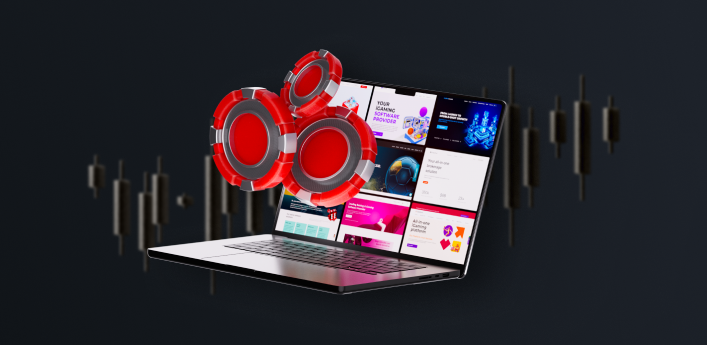
Что такое ECN и STP Форекс-брокеры и как они работают?
В статье
Связывая трейдеров непосредственно с поставщиками ликвидности, два вида брокерских моделей - брокеры ECN и STP Forex - выводят торговцы на рынке иностранной валюты, формируя операционную основу многих Форекс брокерские платформы Полем С помощью прозрачной сети, созданной брокерами ECN, трейдеры могут получить цены в реальном времени и глубокую ликвидность непосредственно от многих участников рынка, поэтому избегая посредников. Маршрутируя заказы прямо к поставщикам ликвидности, брокеры STP упрощают процесс торговли и гарантируют эффективное выполнение торговли без участия в доме. Для трейдеров и будущих владельцев брокеров, знание того, как эти брокеры имеют решающее значение, имеет решающее значение, поскольку это влияет на Торговые методы , расходы и весь опыт торговли.
Понимание брокеров Forex
Выступая в качестве центра между отдельными торговцами и мировым валютным рынком, брокеры Forex являются основой, на которой опирается динамичный мир торговли валютой. Они являются дизайнерами безопасной и благоприятной торговой среды, поэтому позволяют трейдерам договориться о сложной местности обмена валюты.
Форекс брокеры принципиально облегчает операции с иностранной валютой, позволяя трейдерам легко покупать и продавать иностранные валюты. Их задачи сложны; Они поставляют трейдеров платформой, инструментами и доступом к рынку, которые им необходимы для эффективного выполнения своей торговой стратегии. Они обеспечивают критический анализ рынка и информацию, помогая трейдерам в принятии обоснованных и рассчитанных решений на основе таких инструментов, как такие инструменты Торговые показатели и аналитика ликвидности. Для тех, кто надеется войти в брокерскую индустрию, знание ролей и функций брокера Forex очень важно.
You may also like

Типы брокеров Форекс
Брокеры Forex появляются в многочисленных формах, каждый из которых имеет различную эксплуатационную философию и ассортимент продукции. Маркет -производители, которые занимают противоположную сторону позиции трейдера, чтобы обеспечить ликвидность - часто связаны с Ликвидность на стороне покупки и продажи структуры, брокеры ECN, которые предоставляют платформу, на которой игроки рынка могут торговаться друг с другом, и брокеров STP, которые отправляют торговые заказы прямо на Поставщики ликвидности Создать диапазон участников. Понимание многих форм брокеров имеет важное значение, поскольку оно позволяет будущим брокерам и трейдерам соответствовать их решениям с их торговыми требованиями, предпочтениями и планами, тем самым способствуя более гармоническому взаимодействию с динамикой рынка.
Брокеры функционируют в соответствии с несколькими моделями, которые описывают их отношения с рынками и трейдерами. Новые брокерские компании, которые хотят должным образом построить свои услуги и гарантировать лучшие транзакции, должны иметь сильное понимание этих операционных моделей. Операционные рамки - это чертежи, которые направляют разработку брокерских услуг, поэтому гарантируют, что развитая архитектура является сильной, эффективной и в соответствии с динамикой рынка.
Глубоко изучение ядра различных типов брокеров - это не только академические упражнения, но и стратегическую потребность в будущих брокерских компаниях и трейдерах. Он служит основой знаний, которая помогает им точно построить свои торговые и бизнес -планы, что обеспечивает их понимание ритмов рынка и их способность перемещаться вместе с его изменениями. Их отношения с брокерами помогут им сопоставить свою тактику со своими знаниями о брокерах, поэтому укрепляют их связи с рынком и обеспечивая более точное и отзывчивое управление его течениями.
You may also like

Брокеры ECN объяснили
Брокеры ECN выступают в качестве прозрачных каналов на рынке Forex, создавая беспроблемную связь между покупателями и продавцами и обеспечивая цены в режиме реального времени, отражающего непосредственное состояние рынка. Они хорошо подходят для трейдеров, которые ценят прозрачность и часто имеют дело с высокими объемами торговли. Тем не менее, понимание сложной природы и потенциальных затрат, связанных с брокерами ECN, имеет решающее значение для тех, кто новичок в области, чтобы эффективно ориентироваться в ландшафте рынка иностранного валюта.
Электронная сеть связи, или ECN, брокеры предоставляют среду, в которой игроки рынка могут торговаться друг против друга, поэтому избегая необходимости в среднем. Полученная из сложной, но понятной технологии, отражающей состояние рынка, их цены в реальном времени на основе данных из таких инструментов, как соответствующие двигатели и книги заказов и данные о заказе предоставляют трейдерам перспективу глубины рынка. Эта прозрачность имеет первостепенное значение для трейдеров, стремящихся понять непосредственную динамику рынка и стремясь принимать быстрые и информированные торговые решения.
Пригодность и преимущества брокеров ECN
Брокеры ECN хорошо резонируют с торговцами, приоритетными в реальном времени, прозрачном рынке взаимодействия и склонны к высокочастотной торговле. Их ключевая роль в предоставлении мгновенных обновлений цен делает их бесценным активом для тех, кто стремится поддерживать точное чтение динамики рынка и требующую оперативную торговлю. Некоторые из преимуществ:
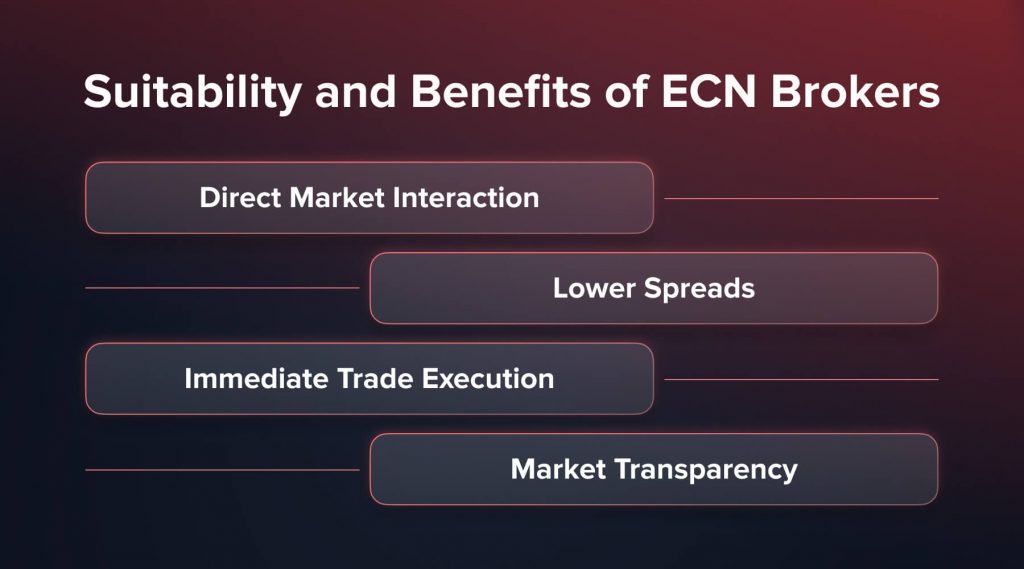
1. Прямое взаимодействие на рынке:
Прямое взаимодействие между трейдерами и брокерными компаниями с поставщиками ликвидности и другими игроками рынка, которое стало возможным благодаря ECN Brokers, помогает повысить конкурентоспособную цену и лучшую информацию о рынке.
2. Нижние спреды:
Из -за увеличения ликвидности, которую они предоставляют, брокеры ECN обычно предлагают более низкие спреды, максимизируя прибыльность торговли за счет снижения транзакционных издержек.
3. Непосредственное исполнение торговли:
На быстро развивающемся рынке Forex трейдеры должны воспользоваться преимуществами рыночных возможностей в режиме реального времени, которые брокеры ECN позволяют с помощью своих высоких скоростей выполнения.
4. Market Transparency:
Доступ к данным заказа в реальном времени помогает трейдерам сделать более точные оценки на основе всей картины рыночных обстоятельств, предоставленных брокерами ECN.
Проблемы и соображения с брокерами ECN
Хотя брокеры ECN имеют много преимуществ, они могут представлять определенные трудности, в основном связанные с их сложной операционной механикой и значительными структурами затрат, что может быть особенно пугающим для начинающих трейдеров и меньших инвесторов. Проблемы включают:
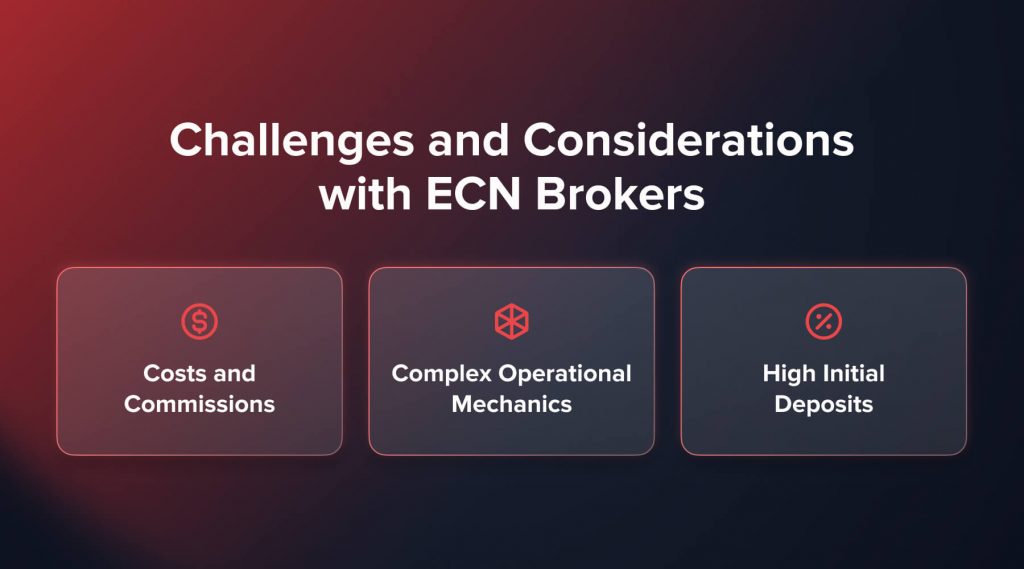
1. Стоимость и комиссионные:
Сборы и комиссионные, связанные с брокерами ECN, могут быть выше, создавая барьер для людей с ограниченным капиталом и потенциально влияя на общую прибыльность торговли.
2. Сложная оперативная механика:
Для людей, которые не знакомы со сложностью рынка Forex, навигация о сложных операциях брокеров ECN может быть пугающей и призывать к кривой обучения, что некоторые из них найдут трудным.
3. Высокие начальные месторождения:
Некоторые брокеры ECN могут требовать крупных начальных депозитов, поэтому за исключением участия меньших трейдеров и новых брокерских компаний.
Прозрачность и обновления в реальном времени
Непревзойденная прозрачность и доставка информации в реальном времени определяют брокерскую компанию ECN в его основе. Эти инструменты позволяют трейдерам смотреть на заказы и цены такими, какие они есть, поэтому направляют свой выбор в зависимости от текущей ситуации рынка. Но наряду с этой прозрачностью возникает необходимость в правильном анализе и интерпретации данных в реальном времени, что требует сильного осознания динамики рынка и резкого взгляда на детали.
Соображения
Стремительные брокеры и трейдеры должны провести тщательную оценку, сопоставляя преимущества в отношении неотъемлемых проблем и оценивая, соответствует ли брокер ECN с их торговыми стратегиями, финансовыми возможностями и общими деловыми целями. Тщательный подход к пониманию операционной динамики, затрат и рыночных взаимодействий, связанных с брокерами ECN, имеет первостепенное значение для эффективного использования их преимуществ и смягчения потенциальных недостатков.
Брокеры STP объяснили
Брокеры STP (прямо через обработку) работают путем передачи заказов непосредственно на рынок, выступая в качестве проводников между трейдерами и поставщиками ликвидности, предлагая более простой и эффективный путь для выполнения торговли. Они уважаются за их оптимизированный подход в облегчении торговых процессов, предлагая простоту использования и более упрощенные структуры ценообразования.
Брокеры STP работают на модели, которая напрямую направляет заказы трейдеров на межбанковский рынок, где торгуют крупные банки. Таким образом, они устраняют необходимость в стержне и обеспечивают никаких помех в порядок, что позволяет провести беспрепятственный опыт торговли.
Операционная динамика
Прямой доступ к рынку
Брокеры STP позволяют трейдерам общаться с преобладающими рынками и ликвидностью в режиме реального времени. Это не только обеспечивает более быстрое выполнение транзакций, но также гарантирует, что трейдеры могут воспользоваться идеальными позициями въезда и выхода, которые имеют решающее значение для ограничения рисков и максимизации возможных доходов на рынке летучих форекс.
Ценовая структура
Брокеры STP часто зарабатывают деньги с помощью спредов, что приводит к более открытой и простой структуре цен. Эта прозрачность стоимости позволяет трейдерам лучше управлять своими торговыми бюджетами, что приводит к более любезной торговой среде, в которой скрытые сборы и комиссии не питаются в прибыли.
Переменные спреды
Спреды в модели STP могут варьироваться, отражая рыночные условия в реальном времени. Эта изменчивость требует, чтобы трейдеры оставались адаптируемыми и бдительными, особенно во время высокой рыночной волатильности, но также дают возможность извлечь выгоду из благоприятных рыночных условий, когда они возникают.
Пригодность и преимущества брокеров STP
Брокеры STP обслуживают широкий спектр трейдеров из -за их сбалансированного и простого подхода. Их оперативная простота и относительная экономическая эффективность делают их жизнеспособным выбором для тех, кто считает модели ECN слишком сложными и дорогостоящими. Преимущества:
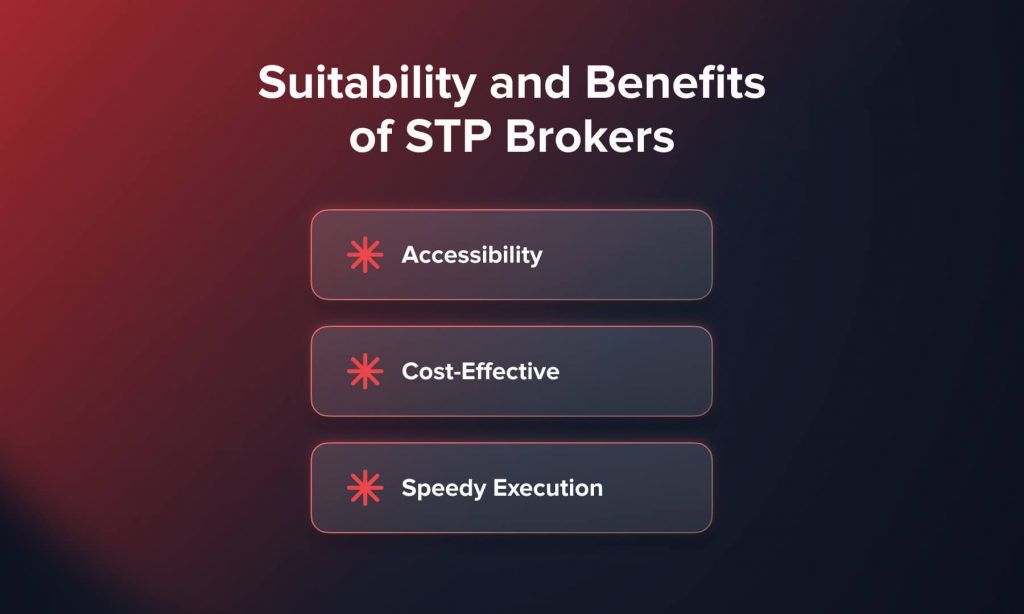
1. Доступность
Оперативная простота брокеров STP означает, что они доступны для более широкой аудитории, от начинающих Форекс, до опытных профессионалов. Эта доступность расширяет возможность для разнообразных торговых стратегий и стилей, приспособленных различных торговых целей и допусков риска.
2. Экономический
Брокеры STP являются привлекательным выбором для людей с ограниченными финансовыми ресурсами или которые не склонны к риску из-за их более высокой предсказуемости и более дешевых сборов. Эта экономическая эффективность позволяет трейдерам посвятить больше ресурсов своей торговой деятельности, возможно, повышая их общую производительность.
3. Скорое исполнение
С помощью их эффективности и скорости исполнения торговли в моделях STP, отставание между размещением заказов и их выполнением снижается, что минимизирует опасность проскальзывания цен и гарантируя, что трейдеры могут использовать возможности рынка, поскольку они представляют себя, используя такие стратегии скальпинг и торговля качанием Полем
Проблемы и соображения с брокерами STP
В то время как брокеры STP дают несколько преимуществ, потенциальные пользователи должны помнить о неотъемлемых проблемах, включая колеблющиеся цены и отсутствие гарантированных сделок. Некоторые из проблем включают:
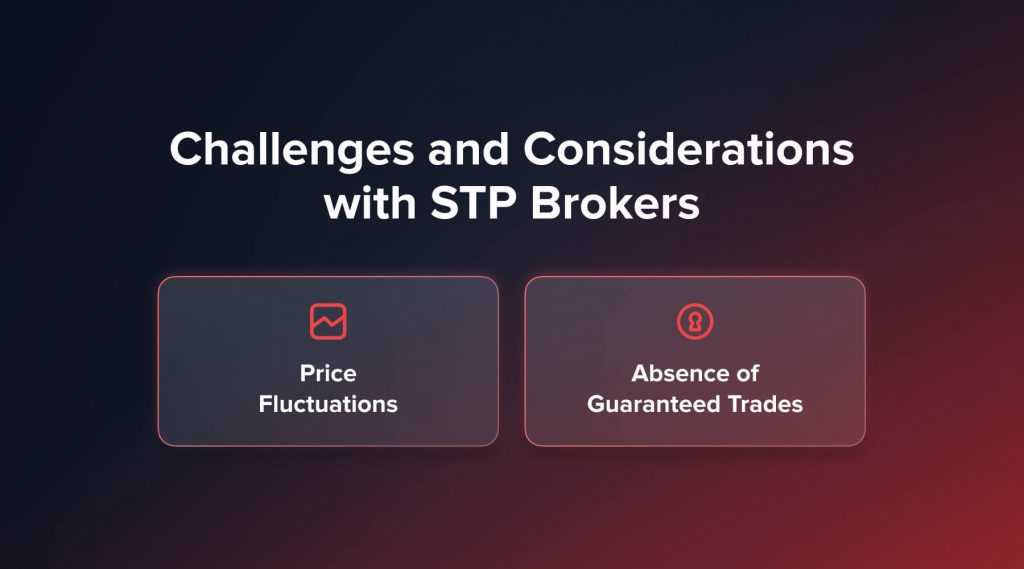
1. Флуктуации цены
Учитывая характер корректировки цен в моделях STP в реальном времени, трейдеры могут испытывать значительные колебания цен, требовать постоянного мониторинга рынка и быстрого принятия решений для обеспечения желаемых торговых цен и эффективного управления потенциальными рисками.
2. Отсутствие гарантированных сделок
Негарантированный характер сделок означает, что существует возможность проскальзывания; Следовательно, трейдеры не всегда могут обеспечить цены, которые они ожидали при размещении заказа. Понимание и предвидение этого аспекта имеет решающее значение для разработки эффективных стратегий управления рисками и поддержания сбалансированного торгового портфеля.
Соображения
Проспективные пользователи брокеров STP должны сначала соответствовать своим оперативным предпочтениям, терпимости к риску и торговым целям с функциями и операционной динамикой брокеров STP. Знание неотъемлемых трудностей и возможных преимуществ поможет трейдерам и потенциальным брокерам максимизировать модели STP, что улучшит их опыт торговли и приведет к постоянно меняющемуся рынку Forex.
ECN против STP - сравнения рисования
При оценке ECN против брокеров STP основание анализа выходит за рамки простого сравнения их характеристик, чтобы определить, какая модель будет сбалансировать операционные склонности, толерантность к риску и торговые цели. Это стратегическое решение, например, выбор правильного автомобиля, который соответствует конкретному требованию, стилю вождения и образу жизни.
Отличительные торговые среды
Брокеры ECN:
Создавая полную торговую среду, брокеры ECN обеспечивают контакт со многими различными игроками рынка. Это создает динамичную среду, в которой трейдеры могут увидеть несколько рыночных точек зрения, поэтому улучшают их рыночные знания и помогая им принимать обоснованные решения. Но этот контакт имеет большую сложность и обычно больше расходов, отсюда и стратегии торговли и Управление рисками Должно быть более точным.
Брокеры STP:
С другой стороны, брокеры STP направляются прямо на рынок без посредников, поэтому обеспечивает более простую торговую среду. Те, кто хочет простых торговых процедур и прозрачных структур ценообразования, найдут эту среду менее сложной и часто более доступной. Тем не менее, простота модели STP может не предложить ту же глубину рыночного понимания, доступной в модели ECN.
Стратегическое выравнивание
Выбор между брокерами ECN и STP включает в себя стратегическое согласование целей торговли, уровня опыта и предпочтения взаимодействия на рынке. Те, кто ищет захватывающую и сложную торговую среду с обширной рыночной информацией, могут склоняться к брокерам ECN, в то время как те, кто ценит простоту и прямой доступ к рынку, могут найти брокеров STP более привлекательными.
Динамика риска и вознаграждения
Внутренний риск и динамика вознаграждения в каждой модели также играют ключевую роль в этом сравнении. Брокеры ECN, с их сложной глубиной и взаимодействием рынка, могут предоставить больше возможностей для сложных торговых стратегий, что может привести к более высоким вознаграждениям. Эти перспективы, тем временем, несут более высокие расходы и риски. И наоборот, брокеры STP могут обеспечить более последовательные и менее рискованные обстановки, но по сравнению с брокерами ECN шансы на сложные стратегии и большие выгоды могут быть меньше.
Обслуживание разнообразных профилей торговцев
Брокеры ECN и STP обслуживают различные виды трейдеров и предпочтений. Из-за своей прозрачности и быстрых изменений цен ECN лучше подходит для опытных трейдеров и тех, кто участвует в высокочастотной торговле. Для ряда трейдеров от начинающих до экспертов STP является более сбалансированным выбором, поскольку его простой подход и снижение сложности отражают их потребности.
Выбор между брокерами ECN и STP - это больше, чем просто рассмотрение затрат или то, как быстро они работают. Речь идет о том, чтобы найти тот, который соответствует тому, как вы любите торговать.
Независимо от того, начинаете ли вы брокерство или просто настраиваете свою собственную настройку, тот вид брокера, который вы выбираете, может действительно изменить то, кто ваши клиенты, какой риск вы рискуете, и сколько денег вы можете заработать.
| Особенность | Брокеры ECN | Брокеры STP |
| Торговля | Сложный, быстро движущийся, с большим количеством игроков и доступной ликвидностью. | Простые, прямые заказы идут прямо к поставщикам ликвидности. |
| Рынок Взгляд | Трейдеры видят тонны цитат и книгу живого заказа. | Достаточно данных для большинства торгов, но не очень подробно. |
| Структура стоимости | Небольшие спреды плюс сборы, которые обычно равняются более высоким затратам. | Спреды шире с меньшими затратами или отсутствием платы, в целом с более низкой стоимостью. |
| Модель исполнения | Прямой матч с другими трейдерами и крупными учреждениями. | Заказы идут прямо к внешней ликвидности. |
| Риск/вознаграждение | Шанс на большие победы, как вы прямо в миксе, но следите за риском. | Меньше шансов на проскальзывание, более устойчивые, но меньше возможностей для огромных успехов. |
| Лучше всего для | Профессиональные трейдеры, алгоритмические трейдеры, фирмы с передовыми стратегиями | Хорошо для начинающих, полупрофессиональных трейдеров и сознательных клиентов. |
| Стратегическое соответствие | Идеально подходит для опытных, высокочастотных и институциональных торговцев, ищущих глубину рынка | Подходит для розничных торговцев и брокерских стартапов, оценивая легкость эксплуатации |
Выбор между брокерами ECN и STP
Выбор правого брокера Forex действительно может изменить вашу торговую игру. Являетесь ли вы новичком бренда или знаете свой путь, знание того, что важно для вас, очень важно.
Подумайте об этом:
Вы хотите снизить расходы, или вы хотите попасть в настоящее сердце рынка?
Брокеры STP обычно стоят меньше всего, но брокеры ECN дают вам фактические спреды, плюс плату, если вы хотите увидеть все действия.
Скорость важнее, или вы просто хотите простых цен?
Брокеры ECN быстры как вспышка и цена в режиме реального времени, в то время как брокеры STP легче использовать и просто дают вам распространение.
Вы торгуете большими суммами или только начинаете работу?
ECN обычно лучше для крупных игроков. Если вы новичок, STP может быть легче справиться.
Если вы только начинаете, брокеров STP легче понять, потому что их цены прямолинейны. Но если у вас часто есть опыт или торговля, брокеры ECN дают вам прозрачность, быстрота и контроль, которые вам необходимы для тщательной торговли.
Наш лучший совет - попробовать как брокера ECN, так и STP с практическими счетами, прежде чем вы вкладываете реальные деньги. Таким образом, вы можете увидеть, как каждый из них работает, как они оценивают вещи, и каковы их платформы, не рискуя деньгами. Это поможет вам принять умное, уверенное решение.
Последние мысли
Владельцы будущих брокеров, которые хотят запустить свои компании, должны сначала изучить специальные операционные стратегии, выгоды и трудности, испытываемые брокерами ECN и STP. Поиск, какая модель соответствует вашей оперативной структуре, потребностям клиентов и видение вашего бизнеса, является более важным, чем утверждать, какой из них является лучшим. Благодаря тщательному сравнению внутренних качеств каждой модели с учетом целей вашей компании и позиционирования на рынке, вы можете максимизировать операционную эффективность и предоставление услуг, тем самым улучшая торговый опыт для ваших клиентов и, таким образом, поощряя счастье и лояльность.
Глоссарий: ключевые термины, которые вы должны знать
Этот список разбивает важные термины Forex, особенно если вы только начинаете, сравниваете брокеров или начинаете свою собственную брокерскую компанию.
- ECN (сеть электронной связи)- Это цифровая настройка, которая автоматически соответствует покупке и продаже заказов у разных людей. Трейдеры получают торговую торговлю друг с другом, вырезая посредника.
- STP (прямо через обработку)- С этой брокерской настройкой ваши заказы отправляются прямо к внешним источникам для ликвидности. Он пропускает сделку, который должен сделать вещи быстрее и проще.
- Поставщик ликвидности- Думайте об этом как о банке, который дает котировки покупки и продажи. Они поставляют необходимую ликвидность, поэтому трейдеры могут открывать и закрывать позиции в Forex.
- Проскальзывание- Это разница между ценой, которую вы думали, что вы получите, и ценой, которую вы действительно получили. Обычно это происходит, когда вещи нестабильны или торговля не очень активна.
- Распространение- Это разница между ценой покупки и продажи валютной пары. Считайте это основной торговой стоимостью и может быть фиксированной или переменной в зависимости от брокера.
FAQ
Это действительно зависит от того, как вы торгуете. ECN более открыт и обычно выполняется лучше, но STP легче, особенно если вы только начинаете.
Да, обычно это так. Брокеры ECN обычно добавляют комиссию к действительно плотным спредам. Брокеры STP, с другой стороны, зарабатывают свои деньги от немного более широких спредов.
Конечно. Некоторые брокеры предлагают как ECN, так и STP, поэтому разные трейдеры могут найти то, что работает для них.
Обновлено:
8 августа 2025 г.



